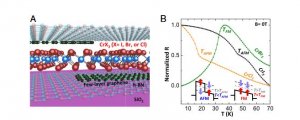Summary
Two-dimensional (2D) layers just one atom thick can be stripped from certain materials, such as graphene. The individual layers from one or more of these materials can then be restacked to create cage-like quantum heterostructures, which possess novel quantum properties. Incorporating magnetism into such a structure at room temperature could enable direct control of electron spin polarization in the transistor geometry. We are working to combine 2D semiconductors and magnetic insulators as an early step toward creation of magnetic semiconductor heterostructures for spintronic devices. Along with proving the heterostructure concept, success in combining the two materials supports a subsequent goal, fabrication of a nanostructure consisting of a superconductor, semiconductor, and magnetic insulator. Achievement of these two goals will provide a fundamental building block for spintronics, address a vital materials challenge in the pathway to quantum computing, and potentially allow for integration of processing and storage technologies in a single device platform.

Figure 1. Magnetic van der Waals tunnel junction incorporating ultrathin chromium trihalides. (A) Schematic illustration of the device. (B) Normalizedtemperature-dependent dc resistance of CrX3(X=I, Br, and Cl) at constant current of 0.1 nA.Insetsshow schematics of the spin-dependent tunnel barrier forAFM and FM interlayer coupling. Red and blue arrows indicate spin orientation and are used throughout. Original illustration from PNAS Publications.
Related Content

Quantum Simulation of Strongly Coupled Field Theories
Strongly-coupled field theories describe both fundamental and applied quantum problems.
August 10, 2017

Harnessing the Promise of Quantum Materials for Future Electronic Devices
Summary Two-dimensional (2D) quantum materials, such as graphene and molybdenum disulfide, have great potential for use in future flexible and wearable electronics applications. With traditional silicon-based electronics nearing their theoretical performance limits, nano-electronics made from 2D quantum materials offer breakthrough opportunities for energy-efficient, wearable ubiquitous computation. In this project, we will study integration of […]
June 14, 2018

A Reformulation of Quantum Game Theory
Summary Classical game theory – conducted at the interface between economics and computer science – has found applications in topics ranging from networking and security to online markets. Despite over 20 years of research into connections between game theory and quantum information, we have yet to see any significant implications of quantum information when applied […]
April 1, 2020

Free-space Polarization-selective Microcavity based on Chiral Metasurfaces
Summary Developing a new type of Fabry-Pérot cavity that allows improved control of the atoms’ emission into the cavity mode will result in enhancement of the efficiency and fidelity of quantum state transfer from photons to atoms and back. This in turn can be used to improve the performance of quantum networks and repeaters, as […]
September 19, 2019

